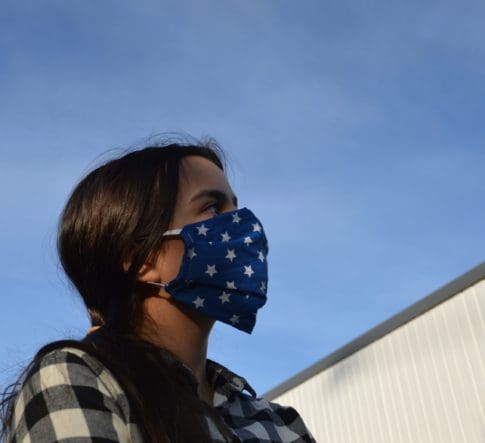Click here to view the full interactives.
The COVID-19 pandemic and associated economic shutdown have led to a severe recession. From March to April 2020, the share of the civilian population in the labor force fell to the lowest level in almost 50 years. However, for some demographics—notably 16- to 19-year-olds—declining labor force participation had been a long-term trend prior to the onset of the COVID-19 recession.
Teen labor force participation peaked in 1979 and has declined ever since, and at an accelerated pace during the past two decades. Prior Hamilton Project work found that from 2000 to 2018, teen labor force participation declined almost 16 percentage points and accounted for more than one third of the 3.6 percentage point decline in overall working-age labor force participation over this time period. The largest contributor to the decline in teen labor force participation was a decrease in the share of teenagers juggling work and school, both during the academic year and over the summer. In the long-term, because those changes have coincided with higher educational attainment, the shift away from work and toward school has plausible, self-evident, and evidence-based benefits.
However, the COVID-19 pandemic has the potential to upend these long-term trends. The severity of the economic shock in combination with school closures could pull teens out of school, out of the labor market, or could cause them to become disengaged from both work and school.
How have teen labor force participation and school enrollment changed so far in 2020? In this analysis, we present two data interactives that let you explore how trends in teen labor force participation and school enrollment during the academic year and the summer have changed in the past 20 years (2000 to 2020) and across the United States in 2020, by gender and race. These data show that teen disengagement from the labor force and school is on the rise.
What are teens doing with their time in 2020?
For any given teen, work and school can be combined in one of four ways: a teen can be (1) a labor force participant and not enrolled in school, (2) both a labor force participant and enrolled in school, (3) enrolled in school and not a labor force participant, or (4) disengaged, meaning that they are neither a labor force participant nor enrolled in school. This interactive map shows how rates of labor force participation and school enrollment differ across U.S. regions for 2020 so far. Toggle between school year (January–May 2020) and summer (June–August 2020) and choose different race and gender options from the drop-down menus to view labor force participation and school enrollment rates for different teenagers.
 The map of regional differences in teenager labor force participation and school enrollment rates during the summer of 2020 shows that Midwestern teenagers are less likely to be exclusively enrolled in school during this period compared to other American teenagers and more likely to be exclusively working. Southern and Western teens are less likely to work and go to school simultaneously than Northeastern and Midwestern teens. Northeastern teenagers have the lowest disengagement rates. Notably, in the Northeast, where 43 percent of teens were exclusively enrolled in school during the summer, more than half of Black teens were exclusively enrolled in school.
The map of regional differences in teenager labor force participation and school enrollment rates during the summer of 2020 shows that Midwestern teenagers are less likely to be exclusively enrolled in school during this period compared to other American teenagers and more likely to be exclusively working. Southern and Western teens are less likely to work and go to school simultaneously than Northeastern and Midwestern teens. Northeastern teenagers have the lowest disengagement rates. Notably, in the Northeast, where 43 percent of teens were exclusively enrolled in school during the summer, more than half of Black teens were exclusively enrolled in school.
Within their respective regions, white teens were more likely than average to be exclusively working and less likely to be exclusively enrolled in school or disengaged. Black teens were more likely to be exclusively enrolled in school or disengaged. Hispanic teens were also likelier to be exclusively enrolled in school, except in the South, and they were slightly more likely to be disengaged. Between January and May 2020 (i.e., during the academic year), Northeastern teens were the least likely to be only working and the most likely to only be enrolled in school, while Midwestern teens were the most likely to be juggling both. Southern teenagers—male, female, white, and Black—were the most likely to be disengaged; Northeastern white and Black female teenagers were least likely to be disengaged.
Limited data from the spring of the 2019–20 school year and the fall of the 2020–21 school year suggest high absenteeism rates: in Los Angeles, Boston, Baltimore, Chicago, Dayton, Hartford, and school districts throughout the country, school leaders are reporting that many students are not consistently engaging in remote learning. Reports additionally show that low-income, Black, and Hispanic students face even greater challenges in keeping up with their schoolwork during the pandemic relative to their higher-income, white, and Asian peers. For example, in Texas public schools, Black and Hispanic students were more than twice as likely as white students to lack full engagement with their teachers during the spring. Economically disadvantaged students were more than three times as likely to lack full engagement relative to their non-economically disadvantaged peers. Moreover, experts worry that high school dropout rates will increase, which could further exacerbate opportunity gaps in learning.
Less engagement with school has not coincided with better labor market outcomes. The COVID-19 pandemic hit teens in the labor force particularly hard. The teen unemployment rate peaked at 31.9 percent in April, which is higher than the unemployment rate of 20–24 year-olds and 25–29 year-olds in each month of 2020. Additionally, youth workers are disproportionately represented in industries at risk of economic contraction during the COVID recession: while 9 percent of all workers work in those industries, 22 percent of workers between the ages of 18 and 24 do. In prior recessions, teens who were out of school responded to high unemployment by returning to school; however, the pandemic has also disrupted education access, so teens may not be able to increase school enrollment.
Is 2020 different for teens?
This sand chart interactive allows you to visualize how teen labor force participation and school enrollment rates have changed over time during the summer and school year, from 2000 to 2020. The sand chart on the left shows teen labor force participation and school enrollment for the last two decades across all demographics. By selecting different combinations of gender and race, the sand chart on the right visualizes how these trends in labor force participation and school enrollment vary by demographic.
 Over time, teenagers in the summer have increasingly substituted school enrollment for labor force participation: the share of teenagers who are only working or seeking work declined by 20 percentage points in the past 20 years, while the share of teenagers who are only enrolled in school increased by 20 percentage points. During the school year, the share of teens exclusively enrolled in school, rather than working or juggling work and school, has increased.
Over time, teenagers in the summer have increasingly substituted school enrollment for labor force participation: the share of teenagers who are only working or seeking work declined by 20 percentage points in the past 20 years, while the share of teenagers who are only enrolled in school increased by 20 percentage points. During the school year, the share of teens exclusively enrolled in school, rather than working or juggling work and school, has increased.
Focusing on changes between 2019 and 2020 can provide insight into the impact of the COVID-19 pandemic on teenagers’ labor force participation and enrollment trends. For example, consider the share of teenagers who are disengaged—neither participating in the labor force nor enrolled in school. Overall and for each subgroup, a statistically significantly higher share was disengaged from January to May 2020 than was from January to May 2019. During the academic year, on average the share of all teenagers engaged only in work or only in school remained constant between the first half of 2019 and 2020, while fewer teens juggled both (January to May 2019–20; authors’ calculations).
Comparing the summer of 2019 with the summer of 2020, again there were statistically significantly more teenagers who were disengaged—overall and for each subgroup. Overall and for every subgroup (except Hispanic female teens), statistically significantly fewer teens were only labor force participants. And while overall fewer teens were juggling labor force participation and school, a statistically significantly higher share of Black female teens were.
Although school closures and distance learning have made it harder to stay enrolled, the lack of jobs for those seeking could also push teens toward disengagement. Between 2019 and 2020, teen unemployment rates increased sharply but unevenly for all ethnic groups: Black teenagers, who had the highest unemployment rate among teenagers in the second quarter of 2019 at 24.2 percent, faced an unemployment rate of 31.7 percent during the same period in 2020. White and Hispanic teen unemployment rates rose to 27.6 and 33 percent, from 11.7 and 14.7 percent respectively. The most striking change is in Asian teenagers’ employment statuses—while only 7 percent of Asian teenagers were unemployed in the second quarter of 2019, 27.6 percent were unemployed during the same time this year.
Conclusion
Over the long term, shifts toward exclusive school enrollment, including during the summer, have meant that while teens are less likely to be engaged in the labor force, they are clearly spending their time productively. Teens who are only enrolled in school spend the most time on education-related activities, while those who juggle work and school spend less time on school than those who are enrolled only, but spend the least time on leisure activities.
As we concluded in the 2019 Hamilton Project economic analysis, “Employment, Education, and the Time Use of American Youth,” to the extent that teens are investing in and incurring returns to their human capital investment, especially when the returns to youth labor force participation are declining, it is time well spent. However, this conclusion is predicated on declining disengagement (the share of teens who are neither working nor in school). While it is too soon to know whether the COVID-19 recession in conjunction with school closures will disrupt long-term trends, disengagement among teenagers increased overall in every U.S. region and across all demographics during the academic calendar months and during the summer of 2020.



